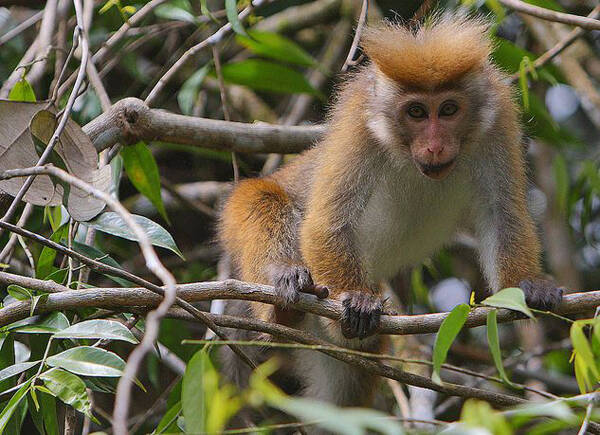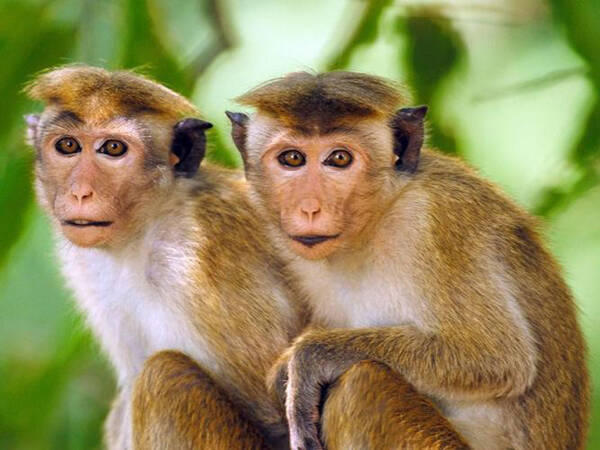Macaca sinica
IUCN
LCBasic Information
Scientific classification
- name:Macaca sinica
- Scientific Name:Macaca sinica,Toque Macaque,Sri Lankan monkey, Lanka macaque, temple monkey
- Outline:Primates
- Family:M.family M.sapiens
Vital signs
- length:43-53cm
- Weight:2.3-8.4kg
- lifetime:About 35 years
Feature
The hair in the center of the head resembles a crown
Distribution and Habitat
Sri Lankan macaques are only found in Sri Lanka. They live in semi-arboreal habitats, mostly in forests, semi-deciduous forests, bushes, rocky cliffs, valleys beside streams, and dense forests along river banks. They are active from plains to 1,500 meters above sea level.
Appearance
The Sri Lankan macaque is 43 - 53 cm long, with a tail length of 47 - 62 cm. It weighs 2.3 - 4.3 kg for females and 4.1 - 8.4 kg for males. It is a sturdy macaque with a crown-like crown of hair in the middle of its head. The hair grows in the opposite direction and has a most unusual spiral growth pattern. Because the English word for this hair cap, "Toque", means a hat without a brim, another Chinese name for this species is the Qimao macaque. The body hair of this species is red or yellowish brown, and the lower body is pale. All individuals have cheek pouches for carrying and storing food when foraging, short and strong limbs, and a long tail. The skin on the face is completely exposed with the eyelids as the border, and the ears are burnt black. The lower lip of males is black, and the rest is pink, while that of females is red. Males tend to be larger than females. There is no swelling of the sexual skin during estrus.
Details
Sri Lankan macaques (scientific name: Macaca sinica) are also known as Toque Macaques. They are primates with three subspecies. This type of monkey is more common in the "Cultural Triangle" area of Sri Lanka where ancient temples are scattered, so it is nicknamed "temple monkey".

Sri Lankan macaques feed, play, chase and move in trees and on the ground. They like to live in groups. When frightened, they quickly escape from the ground in groups. They often move in groups between peaks and valleys, climb peaks and cliffs as if they were walking on flat ground, and like rocky sparse forest slopes. They are more afraid of cold and are diurnal and arboreal animals. They often turn over rocks in small rivers and ditches to pick up dead branches and leaves that have fallen into the ditches in order to find insects, grass leaves, etc. as food. There are many kinds of food, mainly fruits, fresh branches and leaves of plants, flower buds, wild fruits, leaves, crops and insects. After the food is filled in the cheek pouch, it can still be chewed.

Sri Lankan macaques live in groups of about 20, consisting of several adult males and females. Female monkeys generally stay in the group where they were born, but male monkeys tend to disperse to new groups after adulthood. In the same group, there is a strict hierarchy and throne advantage. High-ranking macaques can occupy more ideal and rich foraging areas first, while low-ranking ones are less likely to reproduce their offspring at childbearing age. The mating season is from July to February of the following year, but the mating peak is concentrated in August to November. The breeding season is generally in autumn, the gestation period is 5 months, and the female monkeys reach sexual maturity at the age of 5 to 6 years old. They can give birth to babies for 2 to 3 consecutive years, with one baby per litter. Newborn monkeys have soft black hair, and only grow long hair coats close to those of adult monkeys after two months.
Listed in the "World Conservation Union" (IUCN) ver.: 2008 Red List of Primates - Endangered (EN).
Protect wild animals and eliminate game.
Maintaining ecological balance is everyone's responsibility!








